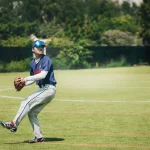Ever tried to keep your swing sharp during the off-season — but the weather, time, or schedule just wouldn’t cooperate? That’s when baseball training aids become your best teammate. Whether you’re a youth player trying to master your timing or an adult rec player working on consistency, the right tools can transform your home into a personal batting cage.
I’ve been there too — standing in the backyard, wishing I could fix my swing without needing a full field or a coach watching. Over time, I learned that you don’t need fancy equipment to make real progress. You just need the right training aids and a little discipline.
Let’s go through the best baseball training aids you can actually use at home — the ones that make a real difference in how you hit, pitch, and move.
1. Hitting Trainers: Build Consistency and Power
When most players think about improving their hitting, they imagine endless reps at the batting cage. But with the right hitting trainer, you can refine your swing mechanics right in your garage.
A swing trainer like a batting tee or a one-hand bat trainer helps you focus on form, not just power. What I like most is how it forces you to slow down and feel your body mechanics — your hip rotation, your hand path, your balance. You’ll notice small flaws you’d never catch in full-speed hitting.
Another excellent home tool is a swing path trainer (like a hanging ball or a resistance band). It teaches you to stay on plane and generate bat speed through controlled resistance.
Pro Tip: Try recording yourself once a week. You’ll be surprised how much cleaner your swing becomes after a month of focused, isolated hitting drills.
2. Pitching Aids: Develop Control and Velocity
You don’t need a full bullpen to work on your pitching. A simple throwing net or rebounder can help you perfect accuracy and consistency. The goal here isn’t just throwing hard — it’s command.
If you’re serious about progress, use a target trainer or a strike zone net with adjustable zones. Visual feedback helps you instantly see where your mechanics break down.
For velocity training, resistance bands are gold. They strengthen your shoulder rotator cuff, improve mobility, and protect your arm from overuse. It’s one of those underrated tools every pitcher should own.
Pro Tip: Combine light band work (10–15 minutes) before and after throwing. It’s the simplest way to gain velocity safely over time.
3. Fielding Tools: Improve Reaction and Soft Hands
Working on fielding at home might sound impossible — but not if you’ve got the right aids.
The reaction ball, with its uneven surface, bounces unpredictably to train your reflexes and glove control. Five minutes of catching this every day can improve your reaction speed more than an hour of grounders.
Another great option is a flat training glove — it forces you to use two hands properly and build the “soft hands” every infielder needs. If you’ve ever fumbled routine grounders, this is the perfect fix.
Pro Tip: Alternate between bare-hand and glove drills. It trains your coordination, soft touch, and muscle memory simultaneously.
4. Strength & Mobility: The Hidden Edge
You can’t swing fast or throw hard without a strong, mobile body. Many players underestimate this — they think strength training is just for the gym.
At home, resistance bands, weighted balls, and balance boards can build that hidden foundation.
- Resistance bands: For shoulders, hips, and core — all key baseball muscles.
- Weighted balls: Improve arm speed safely when used correctly.
- Balance board: Boost stability for both hitting and pitching.
These tools not only make you stronger but also prevent injuries, letting you stay on the field longer.
Pro Tip: Incorporate 15 minutes of band and core work after each training session. It compounds over time and separates advanced players from casual ones.
5. Tracking Tech: Train Smarter, Not Harder
If you’re serious about improvement, tracking data can make a world of difference. You don’t need professional-level tech — even affordable devices like swing analyzers or radar pocket sensors can show your bat speed, launch angle, and throwing velocity.
Think of them as your digital coach. The data doesn’t lie. It helps you understand which drills are working and which aren’t.
Pro Tip: Focus on one metric at a time. For hitters, that’s usually bat speed. For pitchers, command percentage. Master one variable before moving to the next.
How to Choose the Right Baseball Training Aids
When picking your tools, consider these four things:
- Your Goal — Hitting, pitching, or general skill development.
- Your Space — Backyard, garage, or indoor area.
- Your Budget — Start small; a batting tee and net can already do wonders.
- Your Consistency — The best gear won’t help if it collects dust.
Pro Tip: Commit to a simple schedule — 30 minutes a day, 5 days a week. The goal isn’t perfection; it’s progress.
Home Training Routine Example
Here’s a simple weekly structure that actually works:
- Mon / Wed / Fri: Hitting mechanics + swing path trainer (30 mins)
- Tue / Thu: Pitching + resistance bands (20 mins)
- Weekend: Reaction and fielding drills (fun & low intensity)
This balance keeps your body fresh and your skills sharp year-round.
Final Thoughts
At-home training isn’t about replacing the field — it’s about staying ready for it. The best players don’t stop practicing when the season ends; they adapt.
With the right baseball training aids, your home becomes your personal development lab.
You’ll start seeing results not just in performance, but in confidence — because you know you’re improving every single day.
So grab your glove, set up that net, and start building your edge from home.



